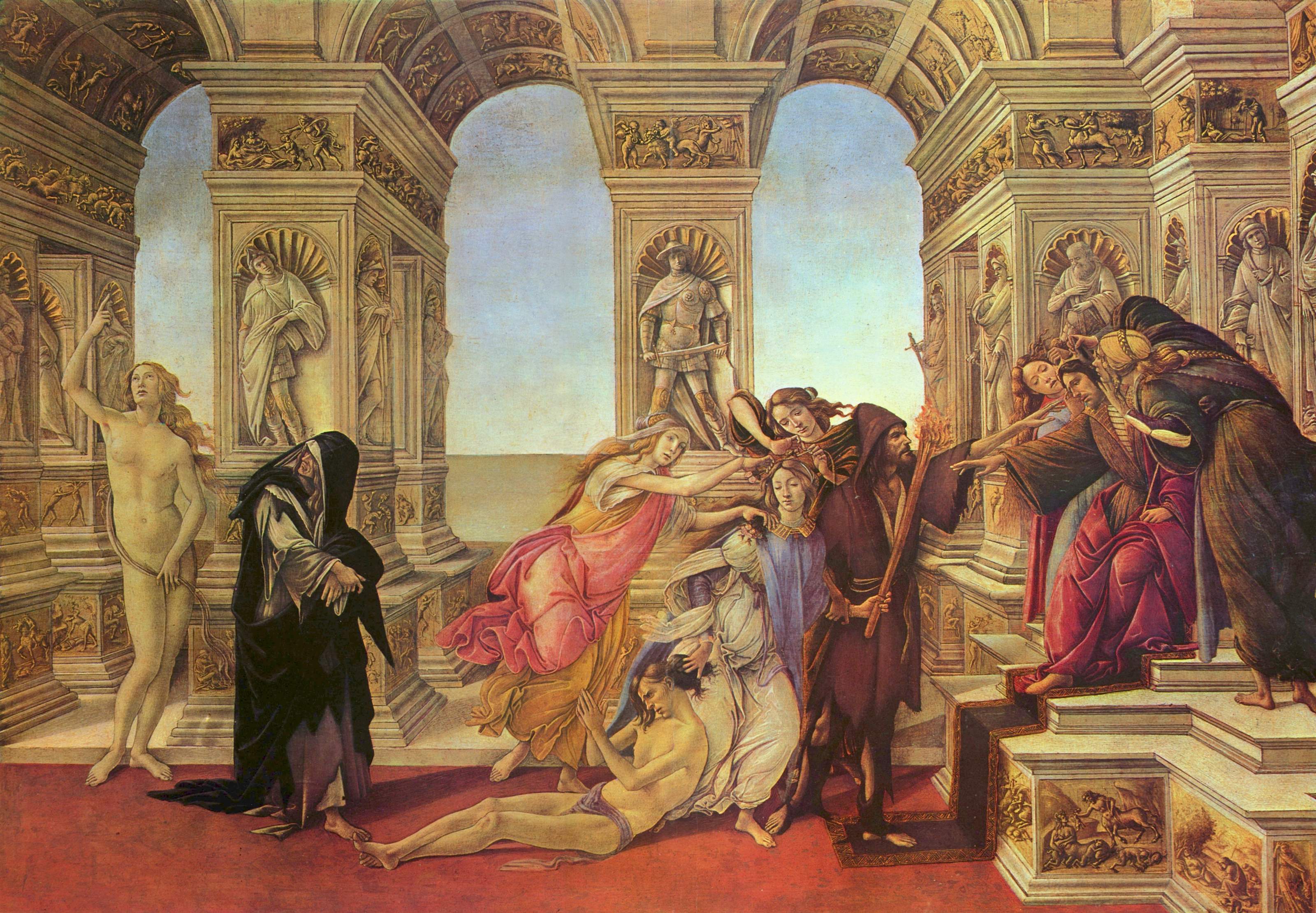- Calumny of Apelles (Botticelli)
title=The Calumny of Apelles
artist=Sandro Botticelli
year=1494-1495
type=Tempera on panel
height=62
width=91
city=Florence
museum=Uffizi"The Calumny of Apelles" (Italian: La Calunnia di Apelle) is a painting by the Italian
Renaissance masterSandro Botticelli ,circa 1494-1495. It is housed in the Uffizi Gallery ofFlorence .Botticelli's theme was drawn from a famous painting by the Greek artist
Apelles , described byLucian in volume four of the surviving collected works of eight volumes. Apelles produced his painting because he was unjustly slandered by a jealous artistic rival, Antiphilos, who accused him in front of the gullible king ofEgypt ,Ptolemy I Soter , of being an accomplice in a conspiracy. After Apelles had been proven to be innocent, he dealt with his rage and desire for revenge by painting this picture.In his essay on "
Slander "', Lucian wrote of the ancient painting:On the right sits a man with long ears almost of the
Lucian's description of this lost work by the classical artist had been widely translated in Botticelli's time.Midas pattern, stretching out a hand to Slander, who is still some way off, but coming. About him are two females whom I take for Ignorance and Assumption. Slander, approaching from the left, is an extraordinarily beautiful woman, but with a heated, excitable air that suggests delusion and impulsiveness; in her left hand is a lighted torch, and with her right she is haling a youth by the hair; he holds up hands to heaven and calls the Gods to witness his innocence. Showing Slander the way is a man with piercing eyes, but pale, deformed, and shrunken as from long illness; one may easily guess him to beEnvy . Two female attendants encourage Slander, acting as tire-women, and adding touches to her beauty; according to the cicerone, one of these isMalice , and the otherDeceit . Following behind in mourning guise, black-robed and with torn hair, comes (I think he named her)Repentance . She looks tearfully behind her, awaiting shame-faced the approach ofTruth . That was how Apelles translated his peril into paint. [http://www.sacred-texts.com/cla/luc/wl4/wl402.htm 1]In his painting, Botticelli kept the scenic structure of the composition of the figures to Lucian's description, and created a lavishly decorated architectural backdrop for them.
An innocent man is dragged before the kings throne by the personifications of Calumny, Malice, Fraud and Envy. They are followed to one side by Remorse as an old woman, turning to face the naked Truth, who is pointing towards heaven. The nakedness of Truth places her in a relationship with the innocent youth, whose folded hands are also an appeal to a higher power.
Remorse ("see left") is shown as an old woman, turning to face the naked Truth. Botticelli based his figure of Truth on the classical type of the Venus Pudica, as well as his own depictions of Venus. She is a naked beauty, an effective opposite to the personification of Remorse, an old, grief-stricken woman in threadbare clothes. Truth, like the innocent youth, is almost naked as she has nothing to conceal. The eloquent gestures and expression of the only towering figure in the painting are pointing up towards heaven, where a higher justice will be meted out.
The king ("see right") is portrayed sitting on the right-hand side of the picture, on a raised throne in an open hall decorated with reliefs and sculptures. He is flanked by the allegorical figures of Ignorance and Suspicion, who are eagerly whispering the rumours in his donkey's ears, the latter to be understood as symbolizing his rash and foolish nature. His eyes are lowered, so as he is unable to see what is happening; he is stretching out his hand searchingly towards Rancour, who is standing before him.
Wikimedia Foundation. 2010.

